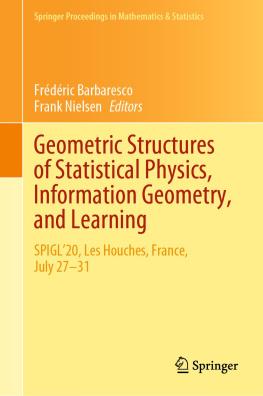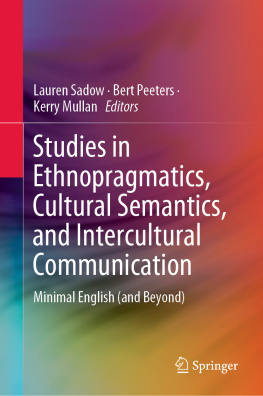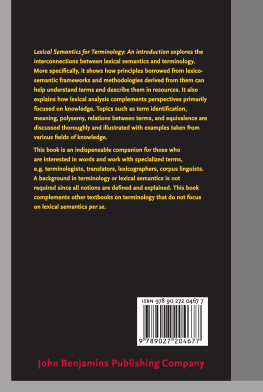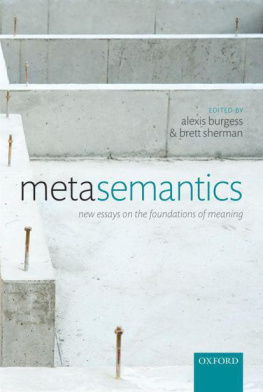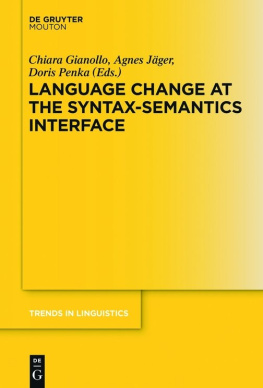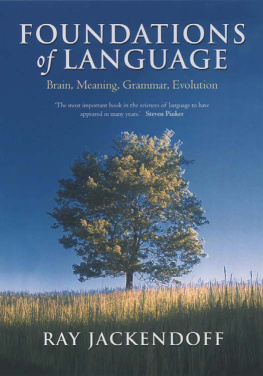Geometry of Meaning
Geometry of Meaning
Semantics Based on Conceptual Spaces
Peter Grdenfors
The MIT Press
Cambridge, Massachusetts
London, England
2014 Massachusetts Institute of Technology
All rights reserved. No part of this book may be reproduced in any form by any electronic or mechanical means (including photocopying, recording, or information storage and retrieval) without permission in writing from the publisher.
MIT Press books may be purchased at special quantity discounts for business or sales promotional use. For information, please email special_sales@mitpress.mit.edu.
This book was set in Stone Sans and Stone Serif by Toppan Best-set Premedia Limited, Hong Kong. Printed and bound in the United States of America.
Library of Congress Cataloging-in-Publication Data
Grdenfors, Peter.
Geometry of meaning : semantics based on conceptual spaces / Peter Grdenfors.
p. cm.
Includes bibliographical references and index.
ISBN 978-0-262-02678-9 (hardcover : alk. paper)
ISBN 978-0-262-31959-1 (retail e-book)
1. Semantics Psychological aspects. 2. Cognition. 3. Cognitive science. 4. Psycholinguistics. I. Title.
P325.5.P78G35 2014
401'.43-dc23
2013022298
10 9 8 7 6 5 4 3 2 1
Contents
Preface
My ambition in this book is to present a cognitive theory of semantics that unifies a large number of areas. It is a continuation and development of the ideas in my book Conceptual Spaces: The Geometry of Thought.
The savanna of semantic research is populated by different kinds of actors. I belong to the giraffes, who try to get a view of the entire landscape. My goal is to present, if not the geography of the meaning space, at least its geometry. Another species of researchers is that of the dung beetles, often found in linguistics departments, who collect their piece of language, for example, a syntactic oddity, and turn it over and over again until they have extracted all its contents. The problem for the giraffe is to be able to reach down to the empirical ground and grasp all the interesting details, while the problem for the dung beetles is to see how the landscape of meaning hangs together. As is well known, these species, and many others, are needed for a well-functioning research landscape. Although my goal is to present a general view of semantics, I hope the book will generate a lot of material for the dung beetles to work on. If my theses are valid, at least to a first approximation, they should provide a rich source for further investigation by researchers in linguistics, cognitive science, and developmental psychology. If not, I would like to see my theses refuted.
I have not been alone in developing the theory presented in this book. Above all, I want to thank my friend and collaborator Massimo Warglien. We have worked together on several of the topics presented here, and we have written a series of papers that have been transformed into chapters or parts of chapters. He is coauthor of most of the material in chapter 4, sections 5.45.7, chapter 9, chapter 10, sections 13.113.3, and the appendix. He has also drawn several of the figures in the book. During our stay in Uppsala during the fall of 2012, Joost Zwarts was a rich source for me concerning linguistic research related to the topics of the book. In particular, we considered the semantics of prepositions, a discussion that resulted in a joint paper that basically contains the material in sections 11.211.6 (the two texts were written more or less in parallel). I also want to thank Simone Lhndorf as a coauthor of a paper that contains the material covered in sections 2.5 and 2.6, and Matthijs Westera, who is a coauthor with Massimo Warglien and me on a paper about events and the semantics of verbs that contains large parts of what is presented in chapter 10 and some parts of chapter 9. Consequently when I write I, I often mean we, although the we is different in different parts of the book. The texts of the coauthored articles have been modified, though, to fit the book as a whole, and I am solely responsible for the results.
Apart from these persons, I have received helpful comments from Richard Andersson, Manfred Bierwisch, Ingar Brinck, William Croft, Markus Egg, Elisabeth Engberg-Pedersen, Hans-Martin Grtner, Emmanuel Genot, Marianne Gullberg, Paul Hemeren, Jim Hurford, Ray Jackendoff, Justine Jacot, Gerhard Jger, Ingvar Johansson, Martin Jnsson, Dunja Jutronic, Manfred Krifka, Werner Kuhn, Ronald Langacker, Asifa Majid, Sabine Marienberg, Carita Paradis, Eric Pedersen, Oleksiy Polunin, Uli Sauerland, Chris Sinha, Leonard Talmy, Jrgen Trabant, Susanne Vejdemo, Annika Wallin, Jordan Zlatev, and participants in the CCL (Cognition, Communication, and Learning) seminars during the spring semester of 2012, when I presented a first draft of the book. I also want to thank Rasmus Bth and Magnus Haake for their help in creating the illustrations in the book and Alan Crozier for checking my English.
During the period of writing, I was generously supported by a number of institutions. I gratefully acknowledge the Swedish Research Council for support to the Linnaeus environment Thinking in Time: Cognition, Communication, and Learning (CCL). My home base, LUCS (Lund University Cognitive Science), and the rest of the Department of Philosophy have provided a critical but friendly test bed for my ideas. Second, the CCL environment in Lund has generated opportunities for new collaborations that have been useful for my research. During the fall semester of 2011, I spent a rewarding period at the Forscherkolleg Bildakt und Verkrperung at the Humboldt Universitt in Berlin, where I had many fruitful discussions concerning visual processes, embodiment, and meaning. During my Berlin sojourn I also had valuable discussions with linguists, in particular Manfred Krifka, at the Zentrum fr Allgemeine Sprachwissenschaft (ZAS). Then, during the fall of 2012, the Swedish Collegium of Advanced Studies (SCAS) in Uppsala provided a highly creative milieu for me and a group of other semanticists.
I
SEMANTICS AS MEETINGS OF MINDS
What Is Semantics?
1.1 What Does It Mean to Understand Communication?
What is it that you know when you know a language? Certainly you know many words of the language (its lexicon), and you know how to put the words together in an appropriate way (its syntax). More important, you know the meaning of the words and what they mean when put together into sentences. In other words, you know the semantics of the language. If you do not master the meaning of the words you are using, there is no point in knowing the syntax. Therefore, regarding communication, semantic knowledge is more fundamental than syntactic.
You can communicate in a foreign language, with some success, just by knowing some words and without using any grammar. Or if you do not know any words of the culture you happen to be in, you can try communicating by gestures, hoping that the intended meaning of your gestures will be transparent to your interlocutor. Thus meaningful communication can occur without a common language. It is not only spoken and written language that has meaning, but also other communicative acts. A continuity exists between verbal and nonverbal communication systems in the way meanings are expressed. A theory of semantics should account for this continuity.
De Saussure (1966) distinguishes between langue (language as a social system of signs) and parole (the individual speech acts). He writes that the signs of language are collective products of social interaction, essential instruments through which human beings constitute and articulate their world, but he never explains how langue can arise from parole. This book presents a theory of semantics that comes in three parts. Part I focuses on how various forms of communication establish a system of meanings that becomes
Next page

